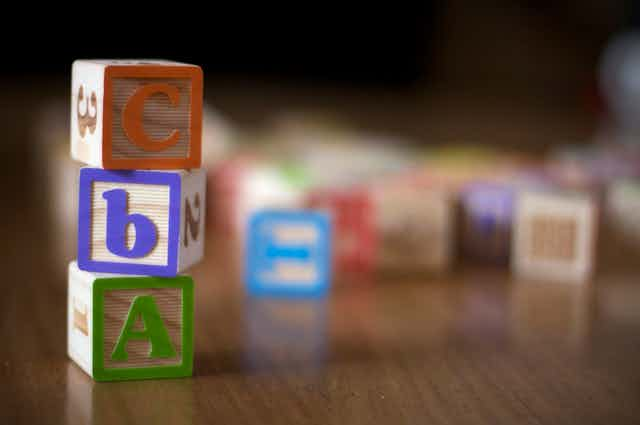A couple of months ago, Japanese mathematician Shinichi Mochizuki posted the latest in a series of four papers claiming the proof of a long-standing problem in mathematics – the abc conjecture.
The announcement created a frenzy of gossip, speculation and a sizeable amount of media attention. It also created hard work for mathematicians, who must now verify Mochizuki’s claims.
Also known as the Oesterle-Masser conjecture (after the mathematicians who proposed it in 1985), the abc-conjecture relates the addition and multiplication of natural numbers – i.e. 1, 2, 3 etc. – in a deep and unexpected way.
As with many difficult problems in number theory, the conjecture involves prime numbers. You’ll recall that a number P is prime if it has exactly two factors (that is, numbers that divide equally into P), namely 1 and P. Thus 11 is prime, but 10 is not, having 1, 2, 5 and 10 as factors.
The abc conjecture
So what is the abc conjecture?
Consider three numbers (A, B and C) that don’t have any common factors greater than 1 and that satisfy the relation A+B=C.
The abc conjecture states that the size of C is bounded above by (roughly) the product of the distinct prime numbers dividing A, B, and C.
Here’s another way of thinking about it: whenever A and B have small prime factors raised to large powers the sum A+B tends to have large prime factors raised to small powers.
The following example should help.
Let’s let A be 210 – which equals 1024 – and B be 58 – which equals 390,625. If we add A and B together we get 391,649. This is the product of two primes – 457 and 857 – and the power of both primes is small (i.e. 1).
The abc conjecture claims that this type of relationship between the prime factors of A, B, and A+B holds in all situations. (The precise formulation of the relationship is slightly more complicated, as it needs to avoid some uninteresting counterexamples.)
This conjecture strengthens and unifies five major mathematical results of the past century, including Fermat’s Last Theorem – the 350-year-old riddle solved, to high acclaim, by Andrew Wiles in 1995.
As Andrew Granville and Thomas J. Tucker noted in their 2002 survey:
Resolving the abc-conjecture would therefore have an extraordinary impact on our understanding of number theory. Proving it or disproving it would be amazing.
It’s been tried before
Previous attempts to settle the conjecture collapsed after close scrutiny. French mathematician Lucien Szpiro sketched a proof at a major number theory conference in New York in the summer of 2007, only to retract it a few months later.
Experts in Mochizuki’s area of number theory are poring over his papers, trying to understand and validate them.
The verification process may take a few years to yield a conclusive verdict. The referees of Andrew Wiles’ first manuscript on Fermat’s Last Theorem found a significant gap, the fix for which required another year and a second paper, jointly written with Richard Taylor.
But Mochizuki writes in a detailed and careful style, providing generous amounts of intuition to guide the reader through his mathematical landscape.
He sports an impressive track record: in 1999 he solved Grothendieck’s anabelian conjecture, which says that algebra dictates the arithmetic and geometry of a curve.
Reviewers heralded this as a “major breakthrough” and a “mathematical gem”, while suggesting that “the proof is very technical and difficult to follow for non-experts (maybe even for experts!)”.
“Inter-universal geometry” – the new framework Mochizuki constructed in the 500 pages of manuscript released in September – emerges as highly original and more technical than his previous work. Even close followers will need time to acclimatise to the new surroundings.
Arithmetic geometry
Arithmetic geometry – the area of mathematics in which the abc conjecture lives – uses an abstract language which was initially designed by French mathematician Alexander Grothendieck in the 1950s.
The driving principle behind arithmetic geometry is that geometry can be expressed in purely algebraic terms – ultimately, in terms of the familiar operations of addition and multiplication.
This astounding idea created a two-way path, along which difficult geometric problems could be solved using algebraic machinery, while abstract algebraic concepts could be understood via the intuition afforded by geometry.
Alas, this framework failed to give a viable attack on the abc conjecture.
Mochizuki’s thesis is that this failure is due to the operations of addition and multiplication being inexorably intertwined.
His solution is to completely dismantle these two operations, to study each of them separately, and to put the two pieces back together in a way that solves the abc riddle.
Most of the work therefore takes place outside the established algebraic-geometric context, in the new world of inter-universal geometry that he constructed for this purpose.
Social acceptance
Despite an unenviable stereotypical portrayal as aloof introverts, mathematicians are social beings. Mochizuki’s proof will only gain widespread acceptance in the community once it has been distilled, simplified, and made much more accessible.
Of course, this work cannot be done by Mochizuki himself.
In past instances, experts held conferences at which they concentrated on different aspects of the proof and produced secondary literature to facilitate easier access to the ideas. Unfortunately, there is typically little external recognition for this type of sustained and dedicated effort.
What’s in it for us?
While many have asked whether Mochizuki has proven the abc conjecture, the more relevant question is: “How solid is his theory?”
The celebrated proofs of major conjectures raise like flags over the peaks of the mathematical landscape but it’s the trails blazed in the process that guide our understanding.
The difficulty in conquering the abc conjecture stems from the subtle mixing of additive and multiplicative properties of the natural numbers.
This complication features in other unsolved problems, and Mochizuki’s latest achievement promises to contribute a new way of attacking such questions.

